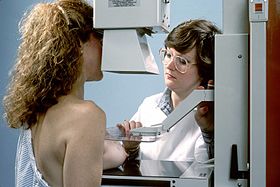Breast cancer screening
| Breast cancer screening | |
|---|---|
| Intervention | |

A woman having a mammogram
|
Breast cancer screening is the medical screening of asymptomatic, apparently healthy women for breast cancer in an attempt to achieve an earlier diagnosis. The assumption is that early detection will improve outcomes. A number of screening tests have been employed, including clinical and self breast exams, mammography, genetic screening, ultrasound, and magnetic resonance imaging.
A clinical or self breast exam involves feeling the breast for lumps or other abnormalities. Medical evidence, however, does not support its use in women with a typical risk for breast cancer.
The use of mammography in universal screening for breast cancer is controversial as it may not reduce all-cause mortality and for causing harms through unnecessary treatments and medical procedures. Many national organizations recommend it for most older women. In the United States screening mammography women at normal risk for breast cancer, is only recommended every two years in women between the ages of 50 and 74. Several tools are available to help target breast cancer screening to older women with longer life expectancies. Similar imaging studies can be performed with magnetic resonance imaging but evidence is lacking.
Earlier, more aggressive, and more frequent screening is recommended for women at particularly high risk of developing breast cancer, such as those with a confirmed BRCA mutation, those who have previously had breast cancer, and those with a strong family history of breast and ovarian cancer.
Abnormal findings on screening are further investigated by surgically removing a piece of the suspicious lumps (biopsy) to examine them under the microscope. Ultrasound may be used to guide the biopsy needle during the procedure. Magnetic resonance imaging is used to guide treatment, but is not an established screening method for healthy women.
Breast examination (either clinical breast exams (CBE) by a health care provider or by self exams) were once widely recommended. They however are not supported by evidence and may, like mammography and other screening methods that produce false positive results, contribute to harm. The use of screening in women without symptoms and at low risk is thus controversial.
...
Wikipedia
